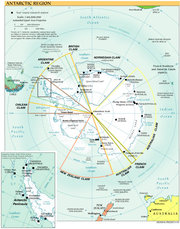Government of Antarctica
|
|
The Antarctic Treaty establishes freedom of scientific investigation and prohibits military activity. The Protocol on Environmental Protection to the Antarctic Treaty prevent development.
| Contents |
The treaty
Antarc-flag2.gif
The Antarctic Treaty, signed on December 1, 1959, and entered into force on June 23, 1961, establishes the legal framework for the management of Antarctica. Administration is carried out through consultative member meetings—the 23rd Antarctic Treaty Consultative Meeting was in Peru in May 1999.
At the end of 1999, there were 44 treaty member nations: 27 consultative and 17 acceding. Consultative (voting) members include the seven nations that claim portions of Antarctica as national territory (some claims overlap) and 20 nonclaimant nations. The United States and some other nations that have made no claims have reserved the right to do so. The US does not recognize the claims of others. The year in parentheses indicates when an acceding nation was voted to full consultative (voting) status, while no date indicates the country was an original 1959 treaty signatory.
Claimant nations
The claims of Argentina, Chile and the UK overlap. The claims of Australia encompass the claim of France.
Nonclaimant consultative nations
- Belgium
- Brazil (1983)
- Bulgaria (1998)
- People's Republic of China (1985)
- Ecuador (1990)
- Finland (1989)
- Germany (1981)
- India (1983)
- Italy (1987)
- Japan
- South Korea (1989)
- Netherlands (1990)
- Peru (1989)
- Poland (1977)
- Russia
- South Africa
- Spain (1988)
- Sweden (1988)
- Uruguay (1985)
- United States
Acceding (nonvoting) members
(year of accession in parentheses)
- Austria (1987)
- Canada (1988)
- Colombia (1988)
- Cuba (1984)
- Czech Republic (1993)
- Denmark (1965)
- Greece (1987)
- Guatemala (1991)
- Hungary (1984)
- North Korea (1987)
- Papua New Guinea (1981)
- Romania (1971)
- Slovakia (1993)
- Switzerland (1990)
- Turkey (1995)
- Ukraine (1992)
- Venezuela (1999)
Articles of the Antarctic Treaty
- Article 1 - area to be used for peaceful purposes only; military activity, such as weapons testing, is prohibited, but military personnel and equipment may be used for scientific research or any other peaceful purpose;
- Article 2 - freedom of scientific investigation and cooperation shall continue;
- Article 3 - free exchange of information and personnel in cooperation with the United Nations and other international agencies;
- Article 4 - does not recognize, dispute, or establish territorial claims and no new claims shall be asserted while the treaty is in force;
- Article 5 - prohibits nuclear explosions or disposal of radioactive wastes;
- Article 6 - includes under the treaty all land and ice shelves south of 60 degrees 00 minutes south;
- Article 7 - treaty-state observers have free access, including aerial observation, to any area and may inspect all stations, installations, and equipment; advance notice of all activities and of the introduction of military personnel must be given;
- Article 8 - allows for jurisdiction over observers and scientists by their own states;
- Article 9 - frequent consultative meetings take place among member nations;
- Article 10 - treaty states will discourage activities by any country in Antarctica that are contrary to the treaty;
- Article 11 - disputes to be settled peacefully by the parties concerned or, ultimately, by the International Court of Justice;
- Articles 12, 13, 14 - deal with upholding, interpreting, and amending the treaty among involved nations.
Other agreements
Other agreements - some 200 recommendations adopted at treaty consultative meetings and ratified by governments - include:
- Agreed Measures for the Conservation of Antarctic Fauna and Flora (1964)
- Convention for the Conservation of Antarctic Seals (1972)
- Convention on the Conservation of Antarctic Marine Living Resources (1980); a mineral resources agreement was signed in 1988 but was subsequently rejected
- Protocol on Environmental Protection to the Antarctic Treaty was signed 4 October 1991 and entered into force 14 January 1998; this agreement provides for the protection of the Antarctic environment through five specific annexes on marine pollution, fauna, and flora, environmental impact assessments, waste management, and protected areas. It prohibits all activities relating to mineral resources except scientific research.
Legal system
From a US perspective, US law, including certain criminal offenses by or against US nationals, such as murder, may apply to areas not under jurisdiction of other countries. Some US laws directly apply to Antarctica. For example, the Antarctic Conservation Act, 16 U.S.C. section 2401 et seq., provides civil and criminal penalties for the following activities, unless authorized by regulation of statute:
- the taking of native mammals or birds;
- the introduction of nonindigenous plants and animals;
- entry into specially protected or scientific areas;
- the discharge or disposal of pollutants;
- the importation into the US of certain items from Antarctica
Violation of the Antarctic Conservation Act carries penalties of up to $10,000 in fines and one year in prison. The Departments of Treasury, Commerce, Transportation, and Interior share enforcement responsibilities.
Public Law 95-541, the US Antarctic Conservation Act of 1978, requires expeditions from the US to Antarctica to notify, in advance, the Office of Oceans and Polar Affairs, Room 5801, Department of State, Washington, DC 20520, which reports such plans to other nations as required by the Antarctic Treaty.
Any crime commited at 50km of distance of any Argentine base is generaly judged in Ushuaia (Argentine Antarctic capital) but, because of the number of people, they are still unable to establish a court in any base
For more information, contact Permit Office, Office of Polar Programs, National Science Foundation, Arlington, Virginia 22230; telephone: (703) 306-1031, or see the website of NSF (listed below).

